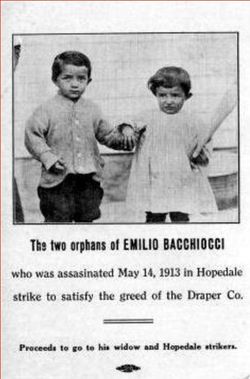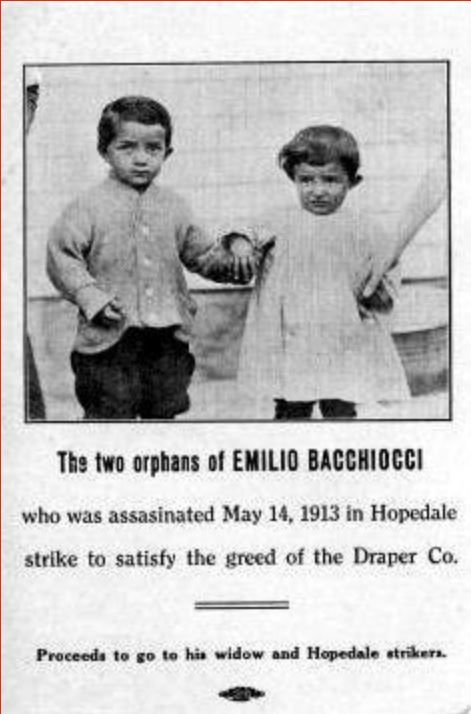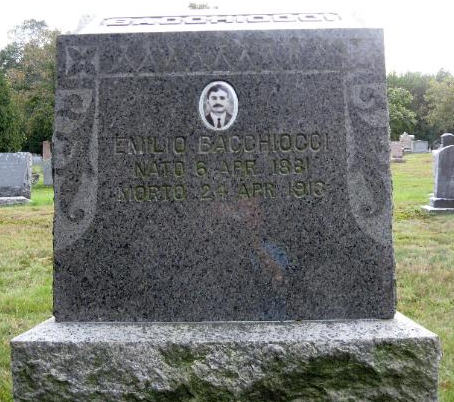On April 1, 1913 more than 1,000 workers, many of whom were Italian immigrants and politically aligned with the Industrial Workers of the World (Wobblies), struck the company after their demands for increased wages, reduced hours, and improved working conditions were ignored by the company. For 24 days strikers and police eyeballed one another. Those tensions finally boiled over on April 24th when the two sides physically clashed. In the violence of that moment Emilio was struck in the back by a bullet from a police officer’s gun.
Thousands of workers and sympathizers turned out for Emilio’s funeral, which public officials incorrectly predicted would lead to further violence. The Italian communities in Hopedale and neighboring Milford were incensed by Emilio’s killing, including shopkeepers who closed their stores and citizenry who donned black armbands. Hopedale police officer Antonio DePasquale, a fifteen-year veteran of the force, turned in his badge. In his letter of resignation, he wrote: “I think that this is the honorable course, as after such an occurrence I do not want to be an officer…I am ashamed to acknowledge that such an act was done.” Special officer Edgar Sherman, who fired the fatal shot, was arrested and charged with manslaughter, however a grand jury declined to indict him.
After the funeral rumored appearances by I.W.W. officials, including Joseph Ettor, Morrison I. Swift, and Elizabeth Gurley Flynn, to rally striking workers did not come to fruition until June. Support for the strike by the rank and file was by that time waning as grim economic realities had set in. Draper Manufacturing maintained an intractable negotiating position. The crushing blow, however, was the eviction of strikers’ families from company owned housing. By July 5, 1913 the strike was officially declared over with virtually the entire workforce returned to their stations. However, 300 of the striking workers were blackballed by the company and forced to relocate elsewhere.
Emilio’s wife Maria, who received $80 in contributions from the community, remarried to Guiseppe Genovali on September 30, 1919.
On April 1, 1913 more than 1,000 workers, many of whom were Italian immigrants and politically aligned with the Industrial Workers of the World (Wobblies), struck the company after their demands for increased wages, reduced hours, and improved working conditions were ignored by the company. For 24 days strikers and police eyeballed one another. Those tensions finally boiled over on April 24th when the two sides physically clashed. In the violence of that moment Emilio was struck in the back by a bullet from a police officer’s gun.
Thousands of workers and sympathizers turned out for Emilio’s funeral, which public officials incorrectly predicted would lead to further violence. The Italian communities in Hopedale and neighboring Milford were incensed by Emilio’s killing, including shopkeepers who closed their stores and citizenry who donned black armbands. Hopedale police officer Antonio DePasquale, a fifteen-year veteran of the force, turned in his badge. In his letter of resignation, he wrote: “I think that this is the honorable course, as after such an occurrence I do not want to be an officer…I am ashamed to acknowledge that such an act was done.” Special officer Edgar Sherman, who fired the fatal shot, was arrested and charged with manslaughter, however a grand jury declined to indict him.
After the funeral rumored appearances by I.W.W. officials, including Joseph Ettor, Morrison I. Swift, and Elizabeth Gurley Flynn, to rally striking workers did not come to fruition until June. Support for the strike by the rank and file was by that time waning as grim economic realities had set in. Draper Manufacturing maintained an intractable negotiating position. The crushing blow, however, was the eviction of strikers’ families from company owned housing. By July 5, 1913 the strike was officially declared over with virtually the entire workforce returned to their stations. However, 300 of the striking workers were blackballed by the company and forced to relocate elsewhere.
Emilio’s wife Maria, who received $80 in contributions from the community, remarried to Guiseppe Genovali on September 30, 1919.
Family Members
Sponsored by Ancestry
Advertisement
Records on Ancestry
Sponsored by Ancestry
Advertisement










